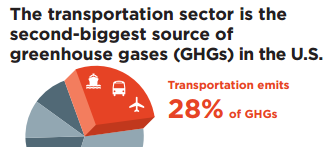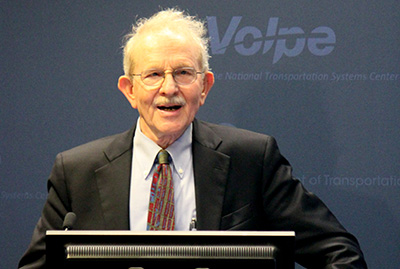Reducing Light-Duty Vehicle Energy Use and GHG Emissions
Whether it’s the sedan you take to work or the taxi you take downtown, each vehicle’s movement is made possible by a deceptively intricate interplay of thousands of moving parts. There’s the engine, connected to the transmission. The transmission’s connected to the driveshaft. The driveshaft makes the wheels rotate. And on and on, up to the gas pedal and the steering wheel.
But without fuel, these marvels of modern invention we call cars would be just big hunks of metal taking up space in our driveways and garages.
“Your vehicle doesn’t go anywhere if it doesn’t have energy fed into it,” said MIT's John Heywood, who spoke as part of Volpe’s Reimagining Transportation series. “You know that, and I know that, but we never actually talk about that.”
Consequences of Covering Vast Distances
 Fossil fuels are the primary way we power vehicles that get people and our goods where they need to go—and the transportation sector is the second-biggest source of greenhouse gases (GHGs) in the U.S.
Fossil fuels are the primary way we power vehicles that get people and our goods where they need to go—and the transportation sector is the second-biggest source of greenhouse gases (GHGs) in the U.S.
“Transportation is special in its energy needs in that the propulsion systems are almost all internal combustion engines today, and they fit what we want remarkably well,” Heywood said. “Except that their impacts are very unattractive, and we’ve got to change those impacts.”
Improve, Conserve, Transform: A Blueprint for Reducing GHGs
Heywood identified three themes for transportation professionals working on reducing greenhouse gas emissions. The first, improve, is about technological innovations that will improve fuel consumption and reduce emissions. This includes shifting new cars and light trucks to more efficient propulsion systems, such as those in electric and hybrid vehicles.
Heywood’s work shows that the use of internal combustion systems may drop over the next three decades, from 90 percent of cars and light trucks on the road to 50 to 60 percent. His research also shows that current alternatives to gasoline engines are in themselves not up to the task of drastically reducing GHGs.
 “The message here is that the options are better, but not fantastic,” Heywood said. “That’s disappointing. We’re really looking for amazing reductions, very demanding reductions.”
“The message here is that the options are better, but not fantastic,” Heywood said. “That’s disappointing. We’re really looking for amazing reductions, very demanding reductions.”
The second theme, conserve, is about reducing vehicle use so that less fuel is used overall. Reducing demand is an untapped area, Heywood said, where transportation planning can change where people live, how far they drive to work, and the availability of public transit that municipalities provide.
The third theme, transform, involves turning over the national vehicle fleet to more efficient technologies. It will take time to achieve significant impacts—where 25 to 30 percent of the national fleet uses engines with little or no GHGs. The transform piece will also depend on market demand and on how governments promote alternative vehicles, such as through emissions caps and fuel taxes, Heywood said.
“These all need to be worked on intensely. I’m not saying number one is more important than number three,” Heywood said. “The challenge is that very few of us can focus on three things at once—seriously focus. We’ve got to seriously focus on three things, not every one of us, but in our thinking and planning, we have to focus on these three.”
